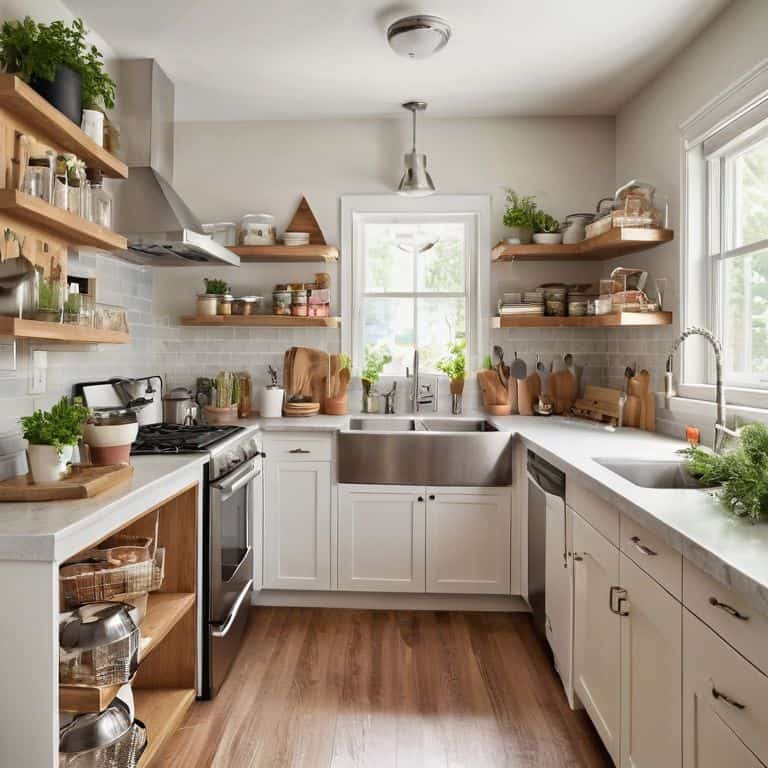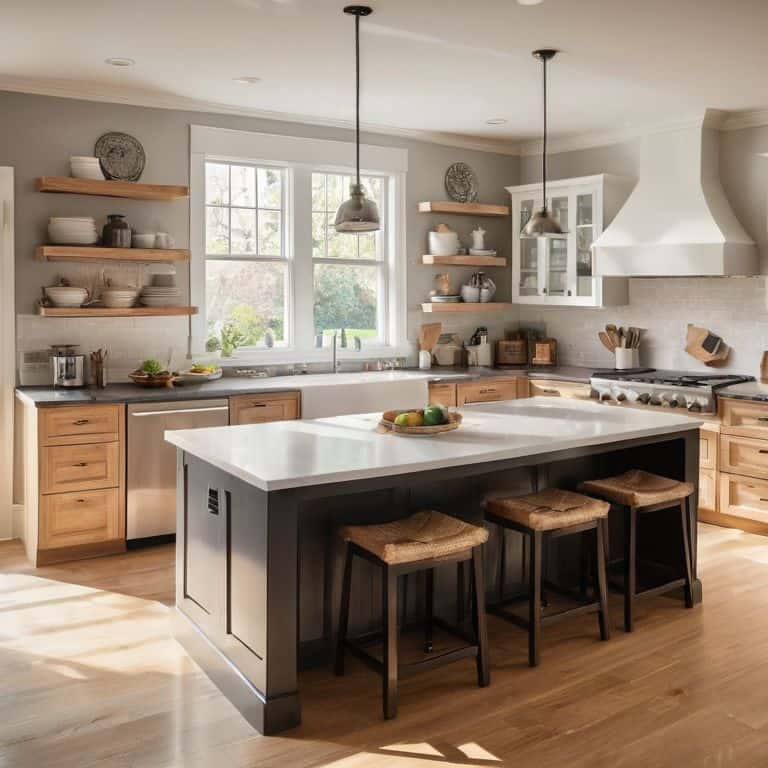I still remember the first time I walked into a kitchen that was supposed to be my dream space, but it felt more like a nightmare. The common kitchen design mistakes to avoid were glaringly obvious, from the poorly placed appliances to the lack of adequate storage. As an interior designer specializing in kitchens, I’ve seen my fair share of design blunders that can turn a cooking haven into a frustrating experience. But I’ve also learned that with a few simple tweaks and a solid understanding of what works, anyone can create a kitchen that’s both beautiful and functional.
In this article, I’ll be sharing my top tips and tricks for avoiding those common kitchen design mistakes that can make or break your cooking experience. From the importance of the kitchen work triangle to clever storage solutions, I’ll give you the honest, no-hype advice you need to create a kitchen that truly works for you. Whether you’re a seasoned chef or a culinary newbie, my goal is to empower you with the knowledge to design a space that inspires your best cooking – and makes the process a whole lot more enjoyable. So, let’s get started on this journey to kitchen perfection, and make those common design mistakes a thing of the past!
Table of Contents
Guide Overview: What You'll Need

Total Time: 2 hours 30 minutes
Estimated Cost: $100 – $500
Difficulty Level: Intermediate
Tools Required
- Tape Measure for accurate measurements
- Level to ensure proper alignment
- Pencil and Paper for planning and sketching
Supplies & Materials
- 6 inches of extra countertop material for mistakes or miscalculations
- Cabinet Hardware to replace poorly chosen or low-quality hardware
- Paint Samples to test colors before committing
Step-by-Step Instructions
- 1. First, let’s talk about the kitchen work triangle, which is the foundation of a functional kitchen. To avoid common design mistakes, start by identifying the three main work areas in your kitchen: the sink, stove, and refrigerator. Ideally, these areas should form a triangle, with each point being about 4-9 feet apart. This will help you create a workflow that’s efficient and easy to navigate.
- 2. Next, take a close look at your pantry organization. A well-organized pantry is essential for a stress-free cooking experience. Start by purging any expired or unused items, and then group similar items together (e.g., all baking supplies in one area). Consider using baskets, bins, or dividers to keep items off the shelves and out of sight, making it easier to find what you need when you need it.
- 3. Now, let’s focus on task lighting, which is often overlooked in kitchen design. To avoid harsh shadows and glare, install a combination of overhead lighting, under-cabinet lighting, and task lighting (such as pendant lights above the island or sink). This will create a warm and inviting ambiance, making it easier to cook and socialize in the kitchen.
- 4. Fourth, consider the workflow of your kitchen. Think about the sequence of tasks you perform when cooking a meal, from preparation to cleanup. Identify any bottlenecks or areas where the workflow is disrupted, and make adjustments accordingly. For example, if you find yourself constantly walking between the sink and stove, consider relocating the stove to a more central location.
- 5. Fifth, don’t forget about storage and layout. A well-designed kitchen should have ample storage for all your cookware, dishes, and gadgets. Consider investing in a kitchen cart or island to provide additional counter space and storage. When designing your layout, think about the golden zone, which refers to the area between 24-48 inches from the floor, where items should be easily accessible.
- 6. Sixth, think about the ergonomics of your kitchen. Avoid placing heavy items, such as stand mixers or slow cookers, in hard-to-reach areas. Instead, store them in easy-to-access locations, such as a pull-out drawer or a countertop near the workstation. This will reduce strain and make cooking more enjoyable.
- 7. Finally, don’t underestimate the power of visual balance in your kitchen design. A visually appealing kitchen can boost your mood and inspire creativity. Consider adding decorative elements, such as a statement light fixture or a colorful rug, to create a welcoming atmosphere. Balance bold patterns and bright colors with neutral elements to avoid visual overwhelm, and don’t be afraid to experiment with different styles until you find the perfect blend.
Avoiding Kitchen Design Blunders

When it comes to avoiding kitchen design blunders, I always emphasize the importance of small kitchen layout ideas that prioritize functionality. A well-designed layout can make all the difference in creating a efficient and enjoyable cooking space. For instance, consider the “kitchen work triangle” principle, which suggests that the sink, stove, and refrigerator should be positioned in a triangular formation to minimize walking distances and maximize workflow.
In addition to a well-planned layout, kitchen lighting layering techniques can also play a crucial role in creating a warm and inviting atmosphere. I like to use a combination of overhead lighting, task lighting, and ambient lighting to create a layered look that’s both functional and aesthetically pleasing. This approach can help to eliminate harsh shadows and create a sense of depth in the kitchen.
To take your kitchen design to the next level, consider investing in efficient kitchen storage solutions that keep your countertops clutter-free and your essentials within easy reach. This might include installing a kitchen island with built-in storage or investing in a pegboard for your utensils and cookware. By implementing these strategies, you can create a kitchen that’s not only beautiful but also highly functional and enjoyable to cook in.
Optimizing Counter Height for Efficiency
When it comes to counter height, a lot of us get it wrong. I’ve seen kitchens where the counters are either too high or too low, making food prep a literal pain. To optimize counter height for efficiency, consider the main tasks you’ll be performing at each station. For example, if you’re a serious baker, you’ll want a lower counter for easy mixing and kneading. On the other hand, if you’re a master chef, you might prefer a slightly higher counter for chopping and dicing.
I like to think of counter height as a personal preference, but with a few key guidelines. Generally, a counter height of 36 inches is ideal for most cooks, but feel free to experiment and find what works best for you. And don’t forget to consider the height of your sink and stove – you want to be able to move comfortably between each station without straining your back. By getting the counter height just right, you’ll be amazed at how much more efficient your kitchen becomes.
Small Kitchen Layout Ideas to Avoid
When it comes to small kitchens, every inch counts. One layout idea to avoid is the “galley gangway” – where the pathway between counters is so narrow, you have to turn sideways to navigate. Not only does this create a claustrophobic feel, but it also hampers workflow. Instead, consider a thoughtful “L” or “U” shape configuration that creates a sense of containment while allowing for a comfortable workflow.
I’ve seen many small kitchens fall into the trap of cramped corners and dead ends. To avoid this, focus on creating a fluid, curved pathway that encourages movement and interaction with your kitchen’s key zones. By doing so, you’ll not only save your sanity but also create a kitchen that’s a joy to cook in, no matter its size.
Kitchen Design Pitfalls to Watch Out For
- Insufficient Lighting: Don’t let poor lighting cramp your cooking style – invest in a combination of overhead, task, and ambient lights to create a warm and inviting atmosphere
- Cluttered Counters: Keep your countertops clear of clutter by incorporating clever storage solutions, such as a utensil organizer or a spice rack, to maintain a sense of visual calm
- Inefficient Workflow: Respect the kitchen work triangle by positioning your sink, stove, and refrigerator in a way that minimizes walking distance and maximizes efficiency
- Improperly Sized Appliances: Choose appliances that fit your cooking needs and the scale of your kitchen – a oversized fridge or stove can be a major design blunder
- Disregarding the ‘Dead Zone’: Don’t forget about the often-wasted space between your cabinets and countertops – use it to store infrequently used items, such as special occasion dishes or cookbooks, to keep them out of the way but still accessible
Key Takeaways for a Harmonious Kitchen
Embracing the kitchen work triangle can significantly enhance your cooking experience by creating a seamless workflow between the sink, stove, and refrigerator
Optimizing your pantry organization and counter height can make a substantial difference in your overall kitchen efficiency, allowing for a more enjoyable cooking process
By avoiding common kitchen design mistakes and incorporating thoughtful design elements, such as ample lighting and strategic storage, you can transform your kitchen into a beautiful, functional space that inspires culinary creativity
Designing with Intention
A kitchen that’s thoughtfully designed is not just a space to cook, but a sanctuary that nurtures both body and soul – and it all starts with avoiding the mistakes that can turn your culinary haven into a chaotic nightmare.
Clara Wu
Bringing It All Together: Creating Your Dream Kitchen

As we’ve explored the common kitchen design mistakes to avoid, it’s clear that attention to detail is key to creating a space that truly works for you. From optimizing counter height for efficiency to clever small kitchen layout ideas, every element plays a role in the overall harmony of your kitchen. By being mindful of the kitchen work triangle and ensuring that your pantry organization reflects your cooking style, you’ll be well on your way to a kitchen that’s both beautiful and functional. Remember, it’s all about finding a balance between form and function that inspires you to cook and share meals with loved ones.
So, as you embark on your kitchen design journey, don’t be afraid to think outside the box and dream big. Your kitchen should be a reflection of your personality and a space where you feel truly alive. By avoiding common design blunders and focusing on what really matters – good lighting, thoughtful layout, and a dash of your own personal style – you’ll be cooking up a storm in no time. And when you do, remember that it’s not just about the food; it’s about the memories you create in the heart of your home, your kitchen.
Frequently Asked Questions
What are the most common kitchen design mistakes that can make a kitchen look cluttered and disorganized?
For me, it’s all about the kitchen work triangle – when it’s disrupted, clutter ensues. Common mistakes include inadequate storage, poor lighting, and insufficient counter space, leading to a chaotic kitchen environment.
How can I avoid wasting space in my kitchen with poor layout choices?
To avoid wasting space, I always recommend applying the ‘kitchen work triangle’ principle, where your sink, stove, and fridge form a triangular workflow. This sacred geometry helps minimize walking distances and maximizes efficiency. Consider a cart or island to add counter space and storage, and don’t forget to leave about 36 inches of clearance around each workstation for comfortable movement.
What are some simple and affordable ways to fix or avoid common kitchen design mistakes in a rental property?
As a renter, it can be tough to make major changes, but there are still ways to optimize your kitchen. Try using adhesive hooks, a cart, or a pegboard to add storage and functionality without damaging the space. You can also update lighting with table lamps or under-cabinet strips to improve ambiance and task lighting.
